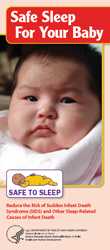Building Tribal Maternal Child Health Epidemiologic Capacity
Sudden Unexplained Infant Death Investigation Training
 Sudden Infant Death Syndrome (SIDS) research informed the Sudden Unexplained Infant Death Investigation (SUIDI) Training Program that was developed by CDC's Division of Reproductive Health (DRH) for infant death investigators.
Sudden Infant Death Syndrome (SIDS) research informed the Sudden Unexplained Infant Death Investigation (SUIDI) Training Program that was developed by CDC's Division of Reproductive Health (DRH) for infant death investigators.
Research includes—
- Risk factors for sudden infant death syndrome among Northern Plains Indians.
- Infant mortality trends and differences between American Indian/Alaska Native infants and white infants in the United States, 1989–1991 and 1998–2000.
- The Aberdeen Area Indian Health Service Infant Mortality Study: Design, Methodology and Implementation [PDF - 293KB].
The training program seeks to standardize death investigations and data collection to aid in accurate reporting of sudden, unexplained infant deaths (SUID). CDC worked with American Indian and Alaska Native (AI/AN) representatives to identify specific training needs and implement training workshops for AI/AN communities, professionals, and those working in the AI/AN community. Sudden Unexplained Infant Death Investigation (SUIDI) Training materials were first presented at the National Indian Program Training Center in Albuquerque, New Mexico, in 2007.

Valid and reliable data are crucial to support research and infant death prevention efforts and to inform stakeholders. For example, the National Institute of Child Health and Development Back to Sleep campaign outreach material— AI/AN Safe Sleep for Your Baby [PDF - 925KB]. This brochure communicates data-based information to the tribal community.
Journals and Special Supplements
In support of an evidence base for improving AI/AN maternal and infant health in the United States, CDC supported a special supplement of the Maternal Child Health Journal published in July 2008, entitled Research for Maternal Child Health Practice in American Indian and Alaska Native Communities.
This was the first MCH Journal issue dedicated to AI/AN and was disseminated to more than 3,500 partners, including all AI/AN tribal health directors. Tribal Epidemiology Centers and AI/AN communities solicited the papers. The 15 original articles in this supplement offer direction for research to improve MCH outcomes in AI/AN communities. They include a broad spectrum of articles ranging from analysis of data sets to primary research spanning pregnancy, motherhood, child rearing, and adolescence.
MCH Epidemiologists Assigned to Tribal Epidemiology Centers
MCH epidemiologists were assigned to serve Tribal Epidemiology Centers (TECs) from 2005 through 2007. In collaboration with the Indian Health Service (IHS), CDC/DRH provided technical support to conduct surveillance, interventions, and outreach to build MCH capacity, specifically to support infant mortality risk reduction projects.
Assignees were supported at the following centers:
- Alaska Native Tribal Health Consortium Epidemiology Center
- Great Lakes Inter-tribal Epi Center
- Inter Tribal Council of Arizona TEC
- Northwest TEC
- United South and Eastern Tribes TEC
- Urban Indian Health Institute
The program was modeled after the CDC MCH Epidemiology Program that supports CDC MCH epidemiologists in state health departments and other organizations that support MCH work. Despite cessation of funding in 2008 to place MCH epidemiologists in TECs, efforts to support MCH epidemiology among Tribal Epi Centers continue.
Tribal Requests for Epidemiologic Assistance
Examples of CDC/DRH epidemiologic assistance include—
- Investigation of reported excess molar pregnancies on a reservation in the Northern Plains.
- Evaluation of a syphilis outbreak on a reservation in the Southwest.
- Investigation of a reported increase in infant and fetal deaths on a reservation in the Northern Plains.
Tribes may contact CDC's Division of Reproductive Health to request assistance.
Additionally, the Council of State and Territorial Epidemiologists (CSTE) partners with CDC and the Association of Schools and Programs of Public Health to support a fellowship program to train and mentor recent graduates in the expanding field of applied epidemiology.
- Page last reviewed: February 8, 2017
- Page last updated: February 8, 2017
- Content source:


 ShareCompartir
ShareCompartir